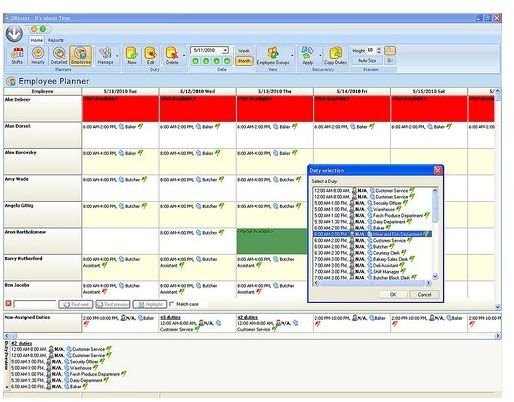Helpful Tips to Manage Project Slippage
1. Manage Resources and Employees Effeciently
Resources are limited in projects so you need to make sure that everything being used is documented and accounted for. Losing track of resources or the budget is a killer and will slow your project’s momentum to a snail’s pace if left unchecked for too long.
You also need to make sure that the proper resources are made available to your project’s employees so there isn’t too much of a fuss when they need something for a portion of the project. Account for surplus and extra resources that can be stored and brought out as needed in case of an emergency.
Another valuable resource you need to keep track of is your employees. Are they happy? Are they working on task? Find out the answers to these questions and work something out to get them to a place where they work comfortably, but keep the project on track. If employees have special skills or a small workload, place them on portions of the project that would benefit from their help.
2. Calculate Your Project’s Critcal Path
Defining your critical path is the most important tip you can take from this article. Your project will have points where the outcome will make or break whether or not you can keep your goals and obligations in check. Define these critical points in the planning stages to create your critical path.
Risk management is key when dealing with a critical path since you wll have to allocate a lot of resources and careful scheduling to keep thing movings. If these critical points are too much to handle you will have to restructure things until it becomes managable again.
3. Offer Incentives to Employees

In the beginning stages of your project you should set aside money to offer your employees incentives for completing goals on time or ahead of schedule. You may hold off on offering these incentives upfront and save them for a time when workflow is becoming sluggish or your project’s schedule is about to line up with a critical point.
Offering incentives will boost morale by rewarding hard work and dedication, encouraging your employees to continue to do hard work in the hopes they are rewarded again in the future.
4. Offer Incentives to Third Parties
Third parties and providers of contracted services need to be managed carefully in order to maintain your project’s balance. Securing orders and services is incredibly important when trying to manage project slippage, especially when it’s crunch time and the only way you can move on in your project is with the help of these people.
Plan ahead and make sure that you have additional room in the budget to offer some incentives. You will then ensure that these goods and services are delivered ahead of schedule or, at the very least, on time. Not only will this help secure your relationship with these third parties, but it will keep your project moving at a smooth pace.
5. Keep a Well-Managed Schedule

Scheduling is perhaps the most important way to manage or prevent project slippage altogether. The schedules that you draft are what everyone is going to be following over the course of the project. If scheduling is not updated or maintained you’re going to find a lot of problems lining everything up correctly the longer the project goes on.
Make sure that the schedule is preened often and that updates are being sent to everyone. Your project’s calender needs to be made available to everyone working on the project in some way. Solutions lie in the use of software and applications, allowing you to sync your schedule with everyone on your team no matter where they are.
6. Create Reachable Deadlines
Deadlines are going to be incredibly daunting for you and your employees. If you notice there is a problem with several of your employees failling to meet the deadlines you’ve laid out there needs to be some re-working on how these deadlines are set. When setting your deadlines make sure they are realistic to the resources and manpower you have available to you.
Preventing deadline slippage isn’t difficult. The easiest and most effective solution is taking larger deadlines and breaking them down into smaller milestones. A month of work then becomes four weeks of smaller tasks that will achieve the same thing. Your employees will thank you; this will help lighten the load and stress of meeting big important deadlines and will boost their morale as they are consistently able to meet these achievable goals.
7. Take Disciplinary Action

If the blame of project slippage lies on employees’ failures to meet their obligations due to poor behavior, make sure it’s known that it will not be tolerated. Lay out a contract or policies that your team members have to agree to in order to establish what is expected of them and show that there will be some form of consequence should they behave wrongly.
If the problem persists start issuing formal reprimands. If the problem continue either replace them, if the issue is severe enough to warrant the action, or create an environment that is more constructive to them.
8. Maintain Communication
Maintaining several channels of communication is a really good way to keep project slippage from happening. Ensure that employees are able to voice concerns and access the resources and tools they need to get the job done right.
Creating a more open and free-flowing communication infrastructure allows information about the project to travel more quickly between team members. This is going to save a lot of time when scheduling changes are made or important notices need to be handed out, and it will make the resources of the project more accessible to those who need them–whenever they may need them.
9. Acquire More Resources or Manpower

If all else fails sometimes you have to manage project slippage by getting more manpower or resources. Do a tally of your resources and manpower and see if anything seems to be falling short. Interview team members and gauge how strenous is the workflow coming their way. With some careful management it’s not difficult to re-work some resources or manpower to get your project back on track, but you may have to visit your stakeholders and ask for additional help.
When you do this be sure to outline every avenue you attempted before coming to the conclusion that additions to the budget were deemed necessary. Don’t be afraid to ask for a little more in order to prevent further risks, but definitely don’t attempt to extend anything too far.
10. Manage the Risks
If your project has a lot of critical tasks and obstacles that it’s going to have to overcome, you may have to get creative with the resources you have at your disposal. Create an effective risk management plan that will cover any unexpected losses and effectively use any surpluses you have in order to minimize any trouble with the project as it carries on.
Coming up with a well-thought-out risk management plan is the most effective way of preventing project slippage from occuring. If you notice that unexpected risks are taking a toll on your project, re-work your plan to include these developments.
References
-
Flickr images - Creative Commons license
Seth Werkheiser of Flickr.com)
-
Google Books - Developing Teams Through Project Learning
-
Google Books - Managing Multiple Project: Planning, Scheduling, and Allocating Resources
